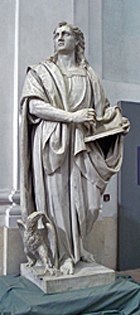

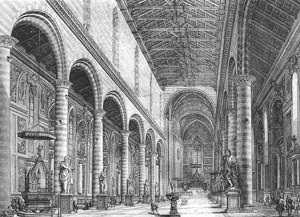
Interior of the Duomo in 1801
The redecoration of the Duomo during the 16th century was effected under the cultural influence of the Counter-Reformation. The programme began in a piecemeal fashion, but it was later developed into an integrated whole. By the time that the work was complete, the Duomo contained works of art by many of the most important sculptors and painters of the day, and represented the epitome of a Counter-Reformation church.
Two factors meant that Orvieto was more successful than other cities in imposing an integrated approach on the interior of its Duomo:
-
✴Private patronage of the Duomo was channeled through a single conduit, the Opera del Duomo.
-
✴This body owed its autonomy to the papacy and cultivated close links with Rome. It was therefore particularly open to the changing religious climate and to its repercussions for church design.
A succession of capomaestri (notably Simone Mosca, Raffaelo da Montelupo and Ippolito Scalza - see below) played a central role in the emerging programme, and they were keen to import the latest artistic trends from Rome. The programme seems to have been sponsored by Cardinal Girolamo Simoncelli, who was bishop of Orvieto in 1554-62. His successor, Bishop Sebastiano Vanzi (1562-71), who distinguished himself at the Council of Trent, must also have played a prominent part. He resigned as he approached death, and Cardinal Girolamo Simoncelli returned to act as bishop of his native city until his death in 1605.
The Mannerist and early Baroque splendour of the interior was lost when the Duomo was remodelled in 1877-91, with a view to returning it to its original state. It was at this point that the interior assumed its current stark appearance. It now requires a good deal of imagination to recreate the appearance of the interior in the 16th - 19th centuries, albeit that:
-
✴some of its sculptural elements remain in place;
-
✴other sculptural elements are exhibited in the ex-church of Sant’ Agostino; and
-
✴the altarpieces from the chapels in the nave are exhibited in the Museo dell’ Opera del Duomo.
This page attempts to describe the remodelling in relation to the factors that stimulated and shaped it.
Veneration of the Consecrated Host
One of the key theological differences between the Church and the emerging Protestant movement revolved around the dogma of transubstantiation - the Catholic belief that the bread and wine of the Mass became the body and blood of Christ after consecration. This issue derailed the attempted reconciliation at the meeting held at Regensburg in 1541, where the leading Protestant theologian, Joachim Melhausen was explicit: It was the opinion of all [the Protestant delegates] that:
-
✴transubstantiation was a fictitious thing;
-
✴that reservation [of the Host] was superstitious; and
-
✴its adoration was idolatrous, or at least dangerous, since it is done without the word of God [i.e. without scriptural justification].
The Catholic response came at the Council of Trent, which, in its 13th session in 1551, reaffirmed "that wonderful and singular conversion of the whole substance of the bread into the Body, and of the whole substance of the wine into the Blood ... which conversion indeed the Catholic Church most aptly calls Transubstantiation". This reaffirmation was particularly important in Orvieto, the home of the Sacro Corporale. It is therefore unsurprising that the earliest phase of the remodelling of the Duomo was driven by the desire to stimulate the veneration of the Host.
Re-positioning of the Canons' Choir (1563)
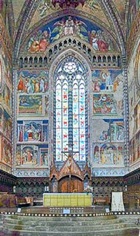
Sacramental Tabernacle (1554-64)
It seems that, in 1536 (i.e. at the time that the choir was moved), Bishop Vincenzo Durante commissioned a new wooden tabernacle for the high altar that would house the consecrated Host.
This was soon to be replaced: the Opera del Duomo and Compagnia del Corpus Christi commissioned a much larger replacement in 1554. The initial plan was for a marble tabernacle. However, this was changed to gilded wood, probably so that the structure could be executed on a more monumental scale. This was one of the earliest sacramental altars of its type in Italy and was designed to provide the devotional focus of the church. Raffaello da Montelupo completed its design in 1558 and Ippolito Scalza executed it in 1558-60. It was installed in ca. 1560 and gilded in 1563. Cesare Nebbia painted eleven panels for it soon after.
From the late 16th century, it became standard practice to house the consecrated Host in a dedicated chapel. Thus, after a pastoral visit in 1623, Cardinal Bishop Pier Paolo Crescenzi decreed that the tabernacle should be removed from the high altar and that the Host should be reserved in the Cappella del Corporale. The tabernacle was actually removed in 1629 and placed at the back of the tribune. It was destroyed in the late 18th century. The panels by Cesare Nebbia were re-discovered recently and are now exhibited in the Museo del Opera del Duomo.
Creation of Spatial Coherence (1562-75)
In the post-Tridentine church, the congregation was required to focus above all else on the drama of the Mass at the high altar. This required an atmosphere of calm that was encouraged by the creation of an uncluttered and symmetrical environment. New funerary monuments were banned from the main part of the church in 1522, and existing ones were removed from 1562. A plan to demolish the chapels in the five niches on each side of the nave and to replace them with new side chapels that were aligned with the pillars was discussed in 1556. However, this plan was rejected in favour of a cheaper alternative that involved building new chapels in the existing niches. Each new chapel was to conform to a design by Raffaello da Montelupo and to be decorated in stucco and fresco, and integrated into the similar decoration of the intervening walls.
Work on the five new chapels in the left aisle began in ca. 1556 and was probably complete by 1570. In that year, Ippolito Scalza (who had been commissioned to decorate on of the altars in the left aisle in 1564 and who been elected capomaestro in 1567) wrote to the Opera del Duomo to urge that marble should be used for the altars in the right aisle, pointing out that the earlier stucco work was already deteriorating. However, the decision ultimately went against him (see below). The programme was completed in stucco by ca. 1575. The new arrangements covered the profusion of votive frescoes in the niches, and set the scene for the installation of an iconographically coherent series of altarpieces (see below).
Organ (1580-8)
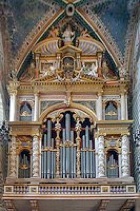
The organ survives in its original location in the interior.
Coherent Iconography
Over the centuries, the Duomo (like other Italian churches) had acquired a collection of votive frescoes that had been applied ad hoc to its walls. These represented exuberant expressions of popular devotion to the cult of saints. The demands of the Counter-Reformation led to their replacement by a more restrained and rational use of art to illustrate the core doctrines of the Church. In keeping with the new emphasis on the Eucharist, the new iconographical programme concentrated primarily on the humanity and the Passion of Christ.
Transept Chapels
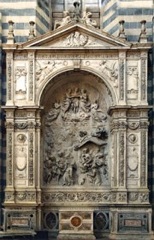
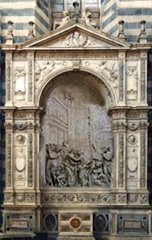
Altare dei Magi Altare della Visitazione
These two chapels survive in situ, to the sides of the presbytery in the interior of the church. The earlier of the two, the Cappella dei Magi, was originally originally a private commission on the part of the Monaldeschi family. However, the project subsequently passed to the Opera del Duomo and, when it was completed, they commissioned the pendant Cappella della Visitazione. These two chapels now became part of an integrated cycle of works of art depicting scenes from the life of Christ.
Altare dei Magi (1514-46)
This altar is in the chapel on the left wall of the right transept of the Duomo, which was ceded to the Monaldeschi della Vipera (or della Sala) in the early 15th century. After the death of Pietro Antonio Monaldeschi della Vipera in ca. 1500, it became the responsibility of his widow, Giovanna Monaldeschi della Cervara. She made a donation for a new altar for the chapel in 1502, and her will of 1509 contained a second donation for its decoration. Michele Sanmicheli, who became capomaestro that year, demolished the earlier altar and began its reconstruction in 1514. When Giovanna died in 1518, the responsibility for the decoration of the chapel passed to the Opera del Duomo, and formed part of the 16th century remodelling.
When Michele Sanmicheli left Orvieto in 1526, only the pediment of the monument had actually been built and the Opera del Duomo commissioned a new design from Antonio da Sangallo il Giovane: his design for part of the altar, which survives in the Uffizi Gallery, Florence, is annotated “per Santa Maria Orvieto, la cappella che cominciò el Verona [i.e. which Michele Sanmicheli had begun]”. Pope Clement VII, who took refuge in Orvieto in December 1527 after the sack of Rome, was asked to decide between the two designs and chose the former, although the side pilaster shown in Antonio da Sangallo’s design was used in the structure that was actually built.
Antonio da Sangallo arranged for Simone Mosca to take over the project in 1535. According the Giorgio Vasari, “there was summoned, at the suggestion of Simone, his very dear friend Raffaello da Montelupo” to work on the central relief under the arch. A document records that Simone Mosca acted as host to Antonio da Sangallo when he made a short visit in 1536 to introduce Raffaello da Montelupo to the authorities.
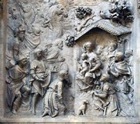
According to Giorgio Vasari, Francesco Mosca, il Moschino subsequently executed the group of angels in the upper part of the central relief, the relief of God the Father in the pediment, the angels in the lunette and the Victories to the sides of it. The chapel itself was finally completed in 1546.
Altare della Visitazione (1547-54)
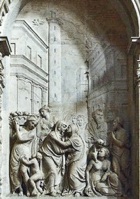
Vasari added that the relief of the Visitation at its centre was commissioned from Simone’s son, Francesco Mosca, il Moschino. The young Ippolito Scalza seems to have worked as an assistant on the project.
In the central relief, the meeting between the Virgin and St Elizabeth prior to the birth of their respective sons is set among buildings that are sketched in deep perspective. Francesco Mosca must have been very proud of this work, because he suggested that the Opera del Duomo should take advice from Michelangelo as to it value. In the event, this suggestion does not seem to have been taken up.
SS Peter and Paul (1556-60)
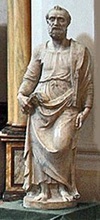
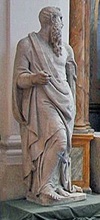
St Peter (1560) by St Paul (1556) by
Raffaello da Montelupo Francesco Mosca, il Moschino
Giorgio Vasari recorded that: “Work being then continued on the execution of the Apostles for the church, [Francesco Mosca, il Moschino] made a St Peter and a St Paul of the same size, which were held to be creditable statues”. Documents relating to this commission began in 1554, when the Opera del Duomo sent Francesco Mosca to Carrara to obtain marble for four planned sculptures:
-
✴these over life-sized statues of SS Peter and Paul;
-
✴a figure of St Sebastian (see below);
-
✴and a group of the Pietà (see below).
The choice of the three saints was probably intended to underline the strong links between Orvieto and papal Rome.
In fact, the marble did not reach Orvieto until 1556, and Francesco Mosca completed only the figure of St Paul before he left Orvieto later that year. The figure was subsequently placed by the first column on the right. Raffaello da Montelupo executed the figure of St Peter in 1560, and this was placed as a pendant to St Paul (i.e. by the first column on the left). These did indeed become the first of a series of figures of the Apostles in the nave.
Both are now exhibited in the ex-church of Sant’ Agostino.
Transept Niches (ca. 1557-70)
According to Giorgio Vasari, “[Simone Mosca] having then returned to Orvieto, arrangements were made to erect after his designs, in the cross at the head of the church, two great tabernacles of marble, works truly graceful, beautiful, and well-proportioned. A payment for these two tabernacles was recorded in 1555.
Giorgio Vasari records the sculptures that were initially placed in these tabernacles:
-
✴“Raffaello da Montelupo made in marble a nude Christ with the Cross on His shoulder in a niche”. In fact, Raffaello da Montelupo had been paid in 1544 for this figure, which had probably inspired by the Risen Christ (1518-20) by Michelangelo in Santa Maria sopra Minerva, Rome. It was subsequently moved to the new niche to the right of the entrance to the Cappella del Corporale.
-
✴“[Francesco Mosca, il Moschino] made a St Sebastian, likewise nude”. This was the third figure for which Francesco Mosca had selected marble in 1554 (see above), and it was unfinished when he left Orvieto in 1556. Ippolito Scalza finished it, and it was then placed in the new niche to the left the entrance to the Cappella Nuova.
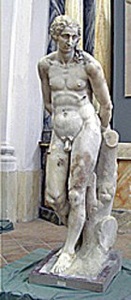
Two further tabernacles were built in 1565-6:
-
✴The niche to the left of the entrance to the Cappella del Corporale housed a figure (1579-82) of the Virgin by Fabiano Toti.
-
✴The niche to the right of the entrance to the Cappella Nuova housed a figure (1560s ?) of Eve attributed to Raffaello da Montelupo.
In ca. 1593, the figure of St Sebastian was moved to the counter-facade, where it formed a pendant there to a figure (1593) of St Roch, another plague saint by Fabiano Toti (see below). Both are now exhibited in the ex-church of Sant’ Agostino.
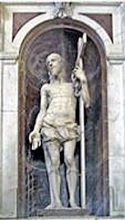
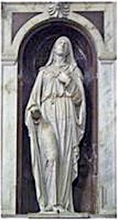
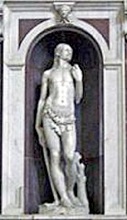
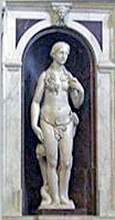
Risen Christ Virgin Adam Eve
Raffaelo da Montelupo Fabiano Toti Fabiano Toti Raffaelo da Montelupo (attr.)
Left transept Right transept
The move of St Sebastian allowed a new arrangement of the statues in the niches, which still survives (as described also in the page on the interior):
-
✴a figure (1575) of Adam, which is attributed to Fabiano Toti, replaced St Sebastian in the right transept; and
-
✴the figures of the Risen Christ and the Virgin in the left transept changed places.
The result was that the figures in the niches now constituted an iconographically rational programme.
Chapels in the Nave (1555-84)
As mentioned above, the altarpieces described below are now in the Museo dell’ Opera del Duomo.
Girolamo Muziano
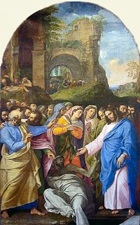
-
✴He had just received a brilliant reception for an altarpiece depicting the raising of Lazarus for Francesco Colonna in Rome, and his first altarpiece (1556) for the Duomo of Orvieto had the same subject (illustrated here).
-
✴The Opera del Duomo almost immediately commissioned a second altarpiece (1557) from him depicting the way to Calvary.
These altarpieces were installed (respectively) on the 4th altar on the left and on the altar opposite. Girolamo Muziano also completed the fresco and stucco decoration of one of the new chapels (probably the 4th on the left) before he left Orvieto in 1558.
Documents suggest that, at least by 1561, the Opera del Duomo had decided that these two altarpieces would form part of two coherent cycles, depicting (respectively):
-
✴the most important of Christ's miracles, as suggested by “theologis et aliis personiis ecclesiasticis” (theologians and other ecclesiastical persons); and
-
✴scenes from the Passion of Christ.
Taddeo Zuccari
Giorgio Vasari records that, “having heard the fame of [Taddeo Zuccari] by means of friends, [the Opera del Duomo of Orvieto] sent a summons to him, and he went to Orvieto, taking with him [Federigo Zuccari, his younger brother - see below]. There, ... he executed two great figures on the wall of one of [the new chapels in the nave], one representing the Active Life, and the other the Contemplative ...; and while Taddeo was painting those figures, Federigo painted three little stories of St Paul in the recess of the same chapel. At the end of which, both having fallen ill, they went away, promising to return in September”.
Surviving documents record payments made to Taddeo Zuccari in 1559 for work in stucco and fresco in the 5th chapel on the left, together with the commission of an altarpiece for it. However, Tadeo never returned and the altarpiece was never painted.
Arrigo Fiammingo and Nicolò Circignani, il Pomarancio
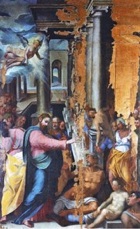
Cesare Nebbia
Cesare Nebbia, who had probably become his associate of Girolamo Muziano during his work on the Duomo in 1556-8, was recorded in his studio in Rome in 1562 and 1566 and probably spent much of the intervening period there. He nevertheless began to solicit work as an independent artist in the Duomo of his native city from 1562. Initially, he had to be content with the commission for the eleven panels for the sacramental tabernacle (see above), which he secured in 1563.
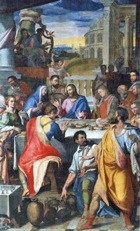
Federico Zuccari
In 1568, Federico Zuccari accepted a commission for two altarpieces for the new chapels of the Duomo.
-
✴He painted the altarpiece (1569) of Christ raising the son of the widow of Nain (for the 2nd chapel on the left). An early drawing for this altarpiece survives in the British Museum and an engraving by Jacob Matham survives in the Villa Mylius-Vigoni, Menaggio (near Como).
-
✴He renewed the frescoes the 5th chapel on the left (which, as noted above, he had worked on in 1559 as an assistant to his older brother Taddeo), and painted its altarpiece (1570) of Christ curing a blind man. Drawings for this altarpiece survive in the Blanton Museum of Art, Texas and in the Musée du Louvre, Paris, and a sketch for a part of it survives in the Morgan Library and Museum, New York.
The Opera del Duomo accepted the request of Federico Zuccari for extra payment for this work in 1572, by which time it was presumably complete.
Girolamo Muziano and Cesare Nebbia (again)
Cesare Nebbia restored his altarpiece of the marriage at Cana in 1572, after it had been damaged in some way. This probably completed the decoration of all the chapels in the left aisle.
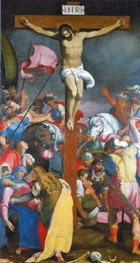
-
✴the Crucifixion (1573-4), in the 5th chapel, illustrated here; and
-
✴the crowning of Christ with thorns (1575), in the 3rd chapel.
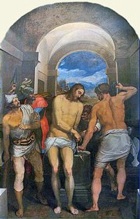
-
✴the flagellation of Christ (1577-84), for the 2nd altar on the left; and
-
✴the capture of Christ (1578-84), , for the 1st altar on the left.
This completed the series of altarpieces in the right aisle that depicted scenes from the Passion of Christ. In 1584, when the Opera del Duomo turned its attention to the mosaic for the tympanum of the facade, it commissioned from Cesare Sermei a cartoon for a scene of the Resurrection, probably as the finale to this narrative cycle.
Statues of Apostles (1579-1600)
As noted above, Giorgio Vasari recorded that: “Work being then continued on the execution of the Apostles for the church, [Francesco Mosca, il Moschino] made a St Peter and a St Paul of the same size, which were held to be creditable statues”. The section above describes the completion of the figure of St Paul (1556) b Francesco Mosca, il Moschino and that of St Peter (1560) by Raffaello da Montelupo. These figures were placed next to the two pillars in the nave nearest the crossing, and a document of 1566 does indeed refer to the intention to complement them by similar figures of the other Apostles.
However, nothing seems to have been done to implement this until 1579, when the Opera del Duomo sent Ippolito Scalza to Carrara to obtain marble for four more statues of the Apostles. This initiated a programme of work that would eventually see all twelve Apostles represented against the columns of the nave, where they would stand among the congregation and represent the pillars of the Church.
-
•St Thomas (depicted as an architect) was installed with great ceremony in 1587; followed by
-
•St John the Evangelist (1588-94), illustrated here.
-
✴In 1589, the third block of marble was assigned to Fabiano Toti for a figure of St Andrew. He duly submitted a design, and was documented at work on the figure in 1589-90. However, the commission passed to Ippolito Scalza in 1594 and it was not completed until 1599.
-
✴The Opera del Duomo turned to Florentine sculptors for the next two figures:
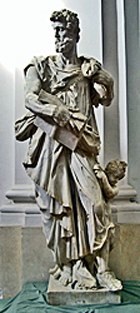
-
•Giovanni Battista Caccini executed the figure of St James Major (1589-91);.
-
•The figure of St Matthew (illustrated here) was commissioned from the leading sculptor, Giambologna in 1595. His initial design and a terracotta model survive in the Museo dell’ Opera del Duomo. However, the execution of the statue was delegated to Pietro Francavilla, who completed it in Florence in 1600. The statue bears the signatures of both men.
The series was completed in the following century (see below). All of the statues were removed in ca. 1890 and are now exhibited in ex-church of Sant’ Agostino.
Counter-facade in the Late 16th Century
Ippolito Scalza began work on remodelling of the counter-facade in 1570. This required the demolition of the oratory (1462) to the right of the main entrance that had housed a venerated image by the Maestro della Madonna di San Brizio. The image was incorporated into the new decorative scheme (although the precise arrangement is unknown) and remained there until 1622, when it was translated with great ceremony to its current location in the Cappella Nuova.
-
✴The Monaldeschi family, who had financed the oratory, must have consented to its demolition. Sforza Monaldeschi della Cervara now offered to finance a new chapel in its place. The offer was quickly accepted and work began in 1575.
-
✴Cornelio Clementini financed a pendant chapel on the other side of the counter-facade in 1576.
Ippolito Scalza incorporated these chapels and the central portal into a unified design. The programme was completed in 1580-1, when the smaller doors to the sides were integrated into the scheme.
The following altarpiece from the counter-facade are now in the Museo dell' Opera del Duomo.
Birth of the Virgin (1582-4)
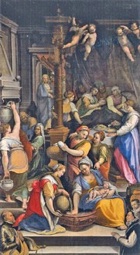
Cesare Nebbia was busy in Rome on work for Pope Sixtus V, and a number of surviving letters document successive delays with this commission. However, the altarpiece was extremely well received when it finally arrived in Orvieto in 1584 (at the same time as the much-delayed altarpieces by Girolamo Muziano - see above). It was removed from the Duomo in ca. 1890 and is now in Room V of the Museo del Opera del Duomo.
St Roch (1593)
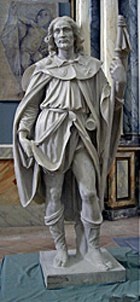
St Constantius (1593-6) and St Brictius (1601)
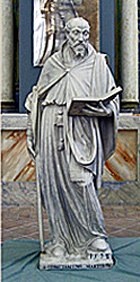
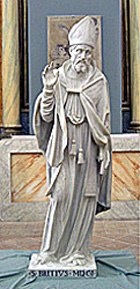
St Constantius (1593-6) St Brictius (1601)
These marble figures by Fabiano Toti were originally in the Cappella Nuova, where they flanked the altarpiece of the Madonna della Stella. They were documented in 1632 on the counter-facade of the Duomo.
17th and Early 18th Centuries
Annunciation (1603-9)
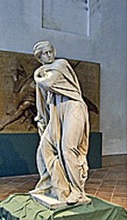
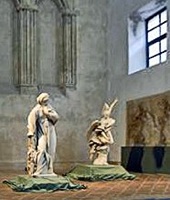
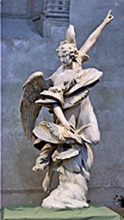
Present arrangement in Sant’ Agostino
In 1603, Duke Mario Farnese secured for his protegé Francesco Mochi a commission to sculpt the figure of St Philip for the series of Apostles in the nave (see below). This was an important opportunity for the young sculptor, since the figure formed part of a series by the leading sculptors of the day. However, before he began, the Opera del Duomo asked him to execute two other, smaller figures, the Archangel Gabriel and the Virgin Annunciate.
The first figure to be delivered (in 1605) was the angel, which Mochi signed and dated by inscription. (The lily that the angel originally carried has been lost). The work was acclaimed for its ethereal quality, for the magnificent technique used to carve the diaphanous drapery, and for the theatricality of the pose. (It is now often regarded as among the earliest in the style that we call the Baroque). Mochi wanted the figure to be placed on the balustrade to the left of the tribune. In this elevated location, bathed in the light from the right, it would impose on the physical space of the congregation in the nave. It was indeed so-positioned for about two years until the Opera del Duomo decided to move it to a less precarious location in the tribune, just inside the balustrade.
The Virgin Annunciate was delivered in 1609. A document from 1612 records that Cardinal Bishop Giacomo Sannesio opposed its installation (perhaps because of the unorthodox pose of the terrified, earth-bound figure and its tight gown). The Opera del Duomo were however satisfied and threatened to seek arbitration from Pope Paul V. There is no record that Paul V was actually consulted, but the figure was installed as a pendant to the angel later in 1612.
The current arrangement of the figures, in the apse of the ex-church of Sant’ Agostino (illustrated above), allows them to be lit from the right, as Mochi originally intended.
Last Four Apostles (1609-1722)
St Philip (1609-10) and St Thaddeus (1638-44)
These figures were commissioned from Francesco Mochi to form part of a cycle of figures of the Apostles in the nave. The figure of St Philip was commissioned shortly before the figure of the Virgin Annunciate (above) was delivered. Francesco Mochi carved it in Orvieto, and delivered it within a year. There followed a protracted wrangle as to its value, and he was not finally paid until 1614, following a determination by the Tribunale della Sacra Rota in Rome.
Francesco Mochi received the commission for the figure of St Thaddeus during a visit to Orvieto in 1638, although it was agreed that he would carve it in Rome. He did not start work on it until 1640 (when work on his statue of St Veronica in St Peter’s ended), and it was not finished until 1644 (the date on its inscription). Damage that it suffered en route from Rome can still be seen.
St Bartholomew (1616-7)
The Roman sculptor Ippolito Buzi was chosen for this commission, after a competition with Pietro Bernini (the father of Gianlorenzo Bernini).
SS James Minor and Simon (1722)
The last two figures in the series were commissioned from the Roman artist Bernardino Cametti in 1714. They were supposed to be delivered after 16 and 36 months respectively, but they were both actually delivered in 1722. The figure of St James is signed and dated by inscription.
Like the rest of the series, these statues are now in the ex-church of Sant’ Agostino.
Christ and the Apostles (1611-12)
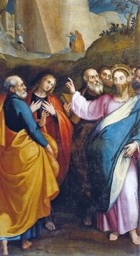
-
✴In the altarpiece exhibited here, Christ sends the Apostles from Jerusalem on missions of evangelisation.
-
✴The second altarpiece, which depicted Christ in the house of Simon, is too badly damaged to be displayed.
Assumption of the Virgin (1714)
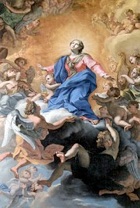
Read more:
The information here was largely drawn from a series of publications by Dr Marietta Cambareri:
"Ippolito Scalza" (with Augusto Roca de Amicis), (2002) Perugia
"Francesco Mochi's Annunciation Group for Orvieto", Sculpture Journal, 6 (2001) 1-9
"Ippolito Scalza e la Transformazione del Duomo di Orvieto nel '500: le Sculture Marmoree", in
G. Barlozzetti (Ed.), "Il Duomo di Orvieto e le Grandi Cattedrali del Duecento", Turin (1995 ), pp 199-212
"A Study in the 16th Century Renovation of Orvieto Cathedral: The Sacramental Tabernacle for the High Altar", in
C. Bozzoni et al. (Eds), "Saggi in Onore di Renato Bonelli", Volume II, Rome (1992), pp 617-22
C. Benocci et al. (Eds), “Storia di Orvieto: Quattrocento e Cinquecento” (2010) Pisa, Volume II contains two particularly relevant articles:
F. Piagnani and L. Principi, “La Scultura del Cinquecento in Orvieto” (pp 585-636); and
P. Tosini, “Il Duomo di Orvieto nella Seconda Metà del Cinquecento: un Modello per la Pittura della Controriforma” (pp 469-88)
Return to the main page on the Duomo.
Continue to: Cappella del Corporale; Cappella Nuova; Crypt.
Return to: Exterior; Facade; Interior.
